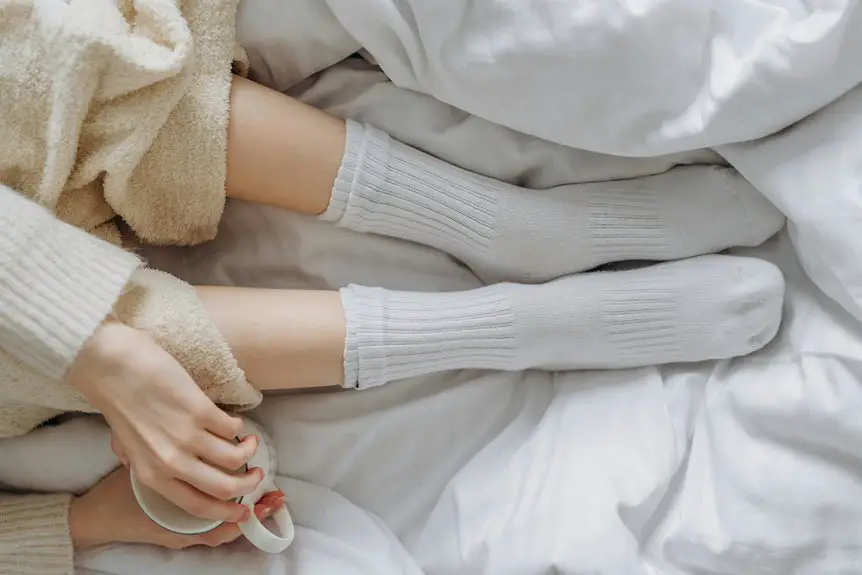To get blood out of white cotton socks, act quickly! Start by gently blotting excess blood with a clean cloth, then rinse the stained area under cold water. For fresh stains, use a gentle bar soap or liquid detergent, letting it sit for 5-10 minutes before rinsing again. For dried stains, try hydrogen peroxide or a baking soda paste. After washing, air dry your socks to avoid setting any remaining discoloration. There’s more to learn about effective techniques!
Table of Contents
Key Takeaways
- Blot the fresh blood stain with a clean cloth and rinse with cold water immediately to lift the stain.
- Apply gentle bar soap or liquid detergent to the stain and let it sit for 5-10 minutes before rinsing again.
- For dried stains, use hydrogen peroxide or a baking soda paste; test on a small area first.
- Soak white cotton socks in cold water for 30 minutes before washing to help remove any residual stains.
- Always air dry socks after washing to prevent any remaining stains from setting.
Understanding Blood Stains on Cotton
When you find a blood stain on your cotton socks, it’s important to understand how blood interacts with the fabric. Blood contains proteins and enzymes that bond with cotton fibers, making the stain more challenging to remove if it sets. The longer you wait, the harder it gets to treat.
Cotton, being absorbent, soaks up the blood quickly, which can lead to deeper penetration into the fibers. The temperature of the water you use also matters; hot water can cook the proteins, causing them to bond more tightly.
Knowing this helps you act swiftly and choose the right methods for treating the stain. Understanding these factors is key to effectively addressing blood stains on your cotton socks.
Initial Steps for Treating Blood Stains
When you notice a blood stain on your socks, the first step is to remove any excess blood gently.
Next, rinse the stained area with cold water to help lift the stain.
Taking these initial steps quickly can make a big difference in how well the stain comes out.
Remove Excess Blood
To effectively tackle blood stains on your socks, start by removing any excess blood as soon as possible. The quicker you act, the better your chances of getting rid of the stain completely.
Here’s how to do it:
- Blot the Stain: Use a clean cloth or paper towel to gently blot the blood. Avoid rubbing, as this can spread the stain.
- Use Cold Water: If possible, hold the stained area under cold running water. This helps lift the blood from the fabric without setting the stain.
- Check for Remaining Blood: After blotting and rinsing, inspect the sock. If there’s still blood, repeat the blotting process until most of it’s removed.
Act fast, and you’ll increase your chances of success!
Rinse With Cold Water
Rinsing the stained area with cold water is crucial for effectively treating blood stains on your socks.
Start by holding the sock under a cold running tap, letting the water flow through the back of the stain. This helps push the blood out of the fabric instead of setting it deeper. Avoid using hot water, as it can cook the proteins in the blood, making the stain harder to remove.
As you rinse, gently rub the fabric to loosen the stain. Make sure you keep rinsing until the water runs clear, which indicates that most of the blood is removed.
This initial step sets the foundation for further treatment, so don’t skip it! Your socks will thank you later.
How to Remove Fresh Blood Stains
Fresh blood stains can be a real hassle, but tackling them quickly makes all the difference. Here’s how you can effectively remove those pesky stains from your white cotton socks:
- Rinse with cold water: Immediately hold the stained area under cold running water. This helps lift the blood before it sets.
- Apply soap: Use a gentle bar soap or liquid detergent. Rub it into the stain and let it sit for about 5-10 minutes to break down the proteins in the blood.
- Rinse again: After soaking, rinse the area under cold water. Check if the stain is gone; if not, repeat the process until it’s completely removed.
Act fast, and you’ll have your socks looking fresh again!
Techniques for Dried Blood Stains
When you’ve got dried blood stains on your socks, you need effective techniques to tackle them.
Hydrogen peroxide and a baking soda paste are two powerful options that can help lift those stubborn marks.
Let’s explore how to use these methods for the best results.
Hydrogen Peroxide Application
Applying hydrogen peroxide to dried blood stains can be an effective way to lift the discoloration from your socks. Here’s how you can do it:
- Test First: Before applying hydrogen peroxide directly, test it on a small, inconspicuous area to verify it won’t damage the fabric.
- Apply Carefully: Pour a small amount of hydrogen peroxide directly onto the stain. You’ll see it fizz as it reacts; this means it’s working!
- Blot and Rinse: Use a clean cloth to gently blot the area, then rinse the sock under cold water.
Repeat if necessary until the stain is gone.
Baking Soda Paste
Baking soda paste can be a powerful ally in tackling dried blood stains on your socks.
To make the paste, mix four tablespoons of baking soda with a few tablespoons of water until you achieve a thick consistency.
Apply this paste directly onto the stained area, ensuring it covers the blood completely. Let it sit for about 30 minutes; this allows the baking soda to break down the stain effectively.
Afterward, gently scrub the area with a soft brush or cloth, then rinse with cold water. If the stain persists, repeat the process.
Finish by laundering your socks as usual. With a little patience, you’ll restore your white cotton socks to their original state, free from blood stains!
Alternative Stain Removal Methods
While traditional methods for removing blood stains can be effective, you might find that alternative stain removal techniques offer a fresh approach.
Here are three methods to evaluate:
- Hydrogen Peroxide: Apply hydrogen peroxide directly to the stain. Let it sit for about 10 minutes before rinsing with cold water. It acts as a gentle bleach and can lift the stain.
- Salt Paste: Mix salt with a bit of cold water to form a paste. Rub it into the stain and let it sit for 30 minutes. Rinse afterward; the salt helps break down the blood.
- Cornstarch: Make a paste with cornstarch and cold water. Apply it to the stain and allow it to dry. Once dry, brush it off; it can absorb the blood effectively.
Give these methods a try!
Effective Laundry Process for Socks
To effectively clean your socks, it’s essential to follow a systematic laundry process.
Start by sorting your socks, separating whites from colors. Check for any visible stains and treat them immediately with cold water. If you have blood stains, soak the sock in cold water for about 30 minutes before washing.
Next, choose a gentle detergent and set your washing machine to a cold water cycle. Avoid using hot water, as it can set the stain.
Once the cycle is complete, avoid tossing your socks in the dryer; instead, air dry them to prevent any remaining stains from setting.
Finally, inspect your socks after washing. If any stains persist, repeat the cleaning process before drying them fully.
Additional Tips for Stain Removal
When tackling stubborn stains, remember that timing and the right techniques matter. You can enhance your stain removal efforts by following these additional tips:
- Cold Water Rinse: Always rinse the sock in cold water immediately after the stain occurs. This helps to prevent the blood from setting in.
- Stain Remover: Use a specialized stain remover or create a paste of baking soda and water. Apply it directly to the stain for better results.
- Gentle Scrubbing: If the stain persists, gently scrub the area with an old toothbrush or cloth. This can help lift the stain without damaging the fabric.
When to Seek Professional Help
Sometimes, despite your best efforts, a blood stain might prove too stubborn to remove on your own. If you’ve tried various home remedies and the stain remains, it’s time to contemplate seeking professional help.
Stubborn stains can sometimes damage the fabric if you continue to scrub or apply harsh chemicals. Additionally, if the socks are particularly valuable or have sentimental value, you wouldn’t want to risk ruining them further.
Professional cleaners have specialized tools and solutions that can effectively treat tough stains without harming the material. If you notice any discoloration or if the stain has set in for too long, getting expert assistance is the safest route to restore your socks to their original condition.
Preventing Future Stains
Although accidents happen, there are several effective strategies to prevent blood stains from ruining your socks in the future. By taking a few simple precautions, you can keep your favorite white cotton socks looking fresh.
Accidents can occur, but with a few simple precautions, you can protect your favorite socks from blood stains.
- Use protective gear: If you’re engaging in activities that might cause cuts or scrapes, wear appropriate safety gear to minimize the risk of blood exposure.
- Handle injuries promptly: If you get a cut, clean it immediately and cover it with a bandage to prevent bleeding on your socks.
- Choose darker socks for messy tasks: When doing chores or engaging in activities where accidents are likely, opt for darker-colored socks that won’t show stains as easily.
Frequently Asked Questions
Can I Use Hot Water to Treat Blood Stains?
You shouldn’t use hot water on blood stains. It can actually set the stain, making it harder to remove. Instead, stick to cold water to help lift the stain effectively without causing more damage.
Will Vinegar Damage My Cotton Socks?
Vinegar won’t damage your cotton socks if used properly. It can actually help lift stains and odors. Just remember to dilute it with water before applying, and always test on a small area first.
How Can I Prevent Blood Stains in the Future?
To prevent blood stains in the future, you should keep first aid supplies handy, act quickly on any cuts, and wear protective clothing during activities that may cause injuries. It’ll save your clothes!
Is It Safe to Mix Hydrogen Peroxide With Other Cleaners?
Did you know that over 30% of cleaning accidents occur due to mixing products? It’s not safe to mix hydrogen peroxide with other cleaners; you could create harmful reactions. Stick to using it alone for best results.
What Should I Do if the Stain Persists After Multiple Treatments?
If the stain persists after multiple treatments, try using a stain remover specifically designed for tough stains. You might also consider soaking the item in cold water with detergent before attempting another treatment.
- Why Do My Linen Clothes Sometimes Develop Pills? - June 11, 2025
- How to Remove Pilling From Chenille Fabric Without Snagging It? - June 11, 2025
- What’s the Best Way to Store Clothes to Minimize Pilling Risks? - June 11, 2025







